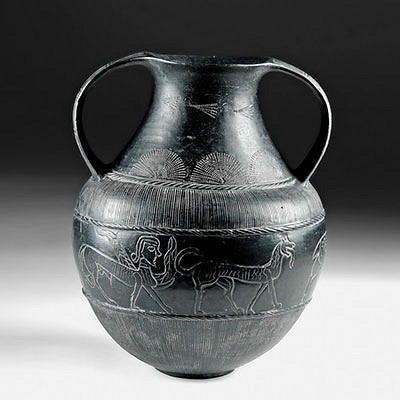Egyptian Mold-Form Glass Fragments - Lions
Lot 5
About Seller
Artemis Fine Arts
686 S Taylor Ave, Ste 106
Louisville, CO 80027
United States
Selling antiquities, ancient and ethnographic art online since 1993, Artemis Gallery specializes in Classical Antiquities (Egyptian, Greek, Roman, Near Eastern), Asian, Pre-Columbian, African / Tribal / Oceanographic art. Our extensive inventory includes pottery, stone, metal, wood, glass and textil...Read more
Categories
Estimate:
$2,200 - $3,300
Absentee vs Live bid
Two ways to bid:
- Leave a max absentee bid and the platform will bid on your behalf up to your maximum bid during the live auction.
- Bid live during the auction and your bids will be submitted real-time to the auctioneer.
Bid Increments
| Price | Bid Increment |
|---|---|
| $0 | $25 |
| $300 | $50 |
| $1,000 | $100 |
| $2,000 | $250 |
| $5,000 | $500 |
| $10,000 | $1,000 |
| $20,000 | $2,500 |
| $50,000 | $5,000 |
| $100,000 | $10,000 |
| $200,000 | $20,000 |
About Auction
By Artemis Fine Arts
Sep 17, 2020
Set Reminder
2020-09-17 10:00:00
2020-09-17 10:00:00
America/New_York
Bidsquare
Bidsquare : CLEARANCE - Ancient, Pre-Columbian, Ethno Art
https://www.bidsquare.com/auctions/artemis-gallery/clearance---ancient-pre-columbian-ethno-art-5605
End-of-Summer Clearance sale featuring discounted pricing on antiquities from Egypt, Greece, Italy, and the Near East...plus Viking, Asian, Pre-Columbian, Tribal, Russian Icons, Spanish Colonial, Fine Art, more! Starting prices have been reduced up to 65% from original auction prices. Artemis Fine Arts info@artemisgallery.com
End-of-Summer Clearance sale featuring discounted pricing on antiquities from Egypt, Greece, Italy, and the Near East...plus Viking, Asian, Pre-Columbian, Tribal, Russian Icons, Spanish Colonial, Fine Art, more! Starting prices have been reduced up to 65% from original auction prices. Artemis Fine Arts info@artemisgallery.com
- Lot Description
**Originally Listed At $1200**
Egypt, Ptolemaic to early Romano-Egyptian period, ca. 332 BCE to first half of 1st century CE. A fantastic set of two mold-formed glass compositions made from opaque glass in mottled hues of citrine, russet, sage, and tan. First is the front end of a regal lion with a short snout bearing puffy jowls, bushy brows, and an incised mane. Second is the curved hind leg of a lion with a padded paw and stocky thigh; this leg is perhaps from a different, larger lion based on the relative size. Feline and leonine images in ancient Egyptian visual culture were very popular as several deities assumed their form. This lion head may represent Maahes, a solar war god commonly referred to as "The Lord of the Massacre" who took the form of a lion. Size (head & body): 2.8" W x 2.75" H (7.1 cm x 7 cm); (leg) 3" L x 0.9" W (7.6 cm x 2.3 cm)
Maahes was the son of Bastet, the cat goddess of Lower Egypt, but also was the son of Sekhmet, the goddess of war in Upper Egypt who also took a feline form. It is believed that his father was Ra or Ptah. Maahes was closely linked with Nefertum and was believed to be the son of both Sekhmet and Bastet. In addition, he was known as the "Avenger of Wrongs" and the "Helper of Wise Ones" and considered to be the guardian of sacred places and the protector of the innocent.
Several other Egyptian gods were depicted as a lion. These included: Apedemak - a war god from Nubia; Arensnuphis - companion to Isis also from Nubia; twin lion gods Ruty, a name that means "pair of lions"; Shesmetet, a leonine goddess with the body of a woman but the head of a lion who is regarded as an aspect of Bastet or Sekhmet, only an older deity; and Tefnut, the goddess of moisture and daughter of Ra who is depicted as a seated woman with a lion's head.
For a few good examples of glass inlays from the same time period, please see: Stern, E. Marianne and Birgit Schlick-Nolte. "Early Glass of the Ancient World: 1600 B.C. - A.D. 50 | Ernesto Wolf Collection." Verlag Gerd Hatje, Germany, 1994, pp. 358-364, figs. 115-118.
Provenance: ex-Dr. Sid Port collection, California, USA, acquired in the 1970s; ex-Norman Blankman collection, New York, USA, acquired in the 1950s in Cairo, Egypt
All items legal to buy/sell under U.S. Statute covering cultural patrimony Code 2600, CHAPTER 14, and are guaranteed to be as described or your money back.
A Certificate of Authenticity will accompany all winning bids.
We ship worldwide and handle all shipping in-house for your convenience.
#153329Both items are fragments of larger glass compositions and have been professionally cleaned and conserved. Repair to back of lion's body, with resurfacing along break lines on verso. Each item has minor nicks and abrasions to front, peripheries, and verso, with light encrustations, and minor softening to some finer details. Great glass color throughout.Condition
- Shipping Info
-
All shipping is handled in-house for your convenience. Your invoice from Artemis Gallery will include shipping calculation instructions. If in doubt, please inquire BEFORE bidding for estimated shipping costs for individual items.
-
- Buyer's Premium



 EUR
EUR CAD
CAD AUD
AUD GBP
GBP MXN
MXN HKD
HKD CNY
CNY MYR
MYR SEK
SEK SGD
SGD CHF
CHF THB
THB













